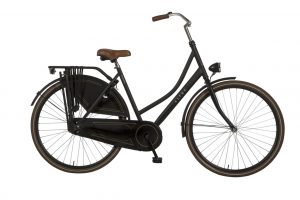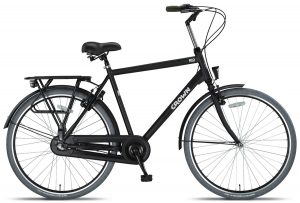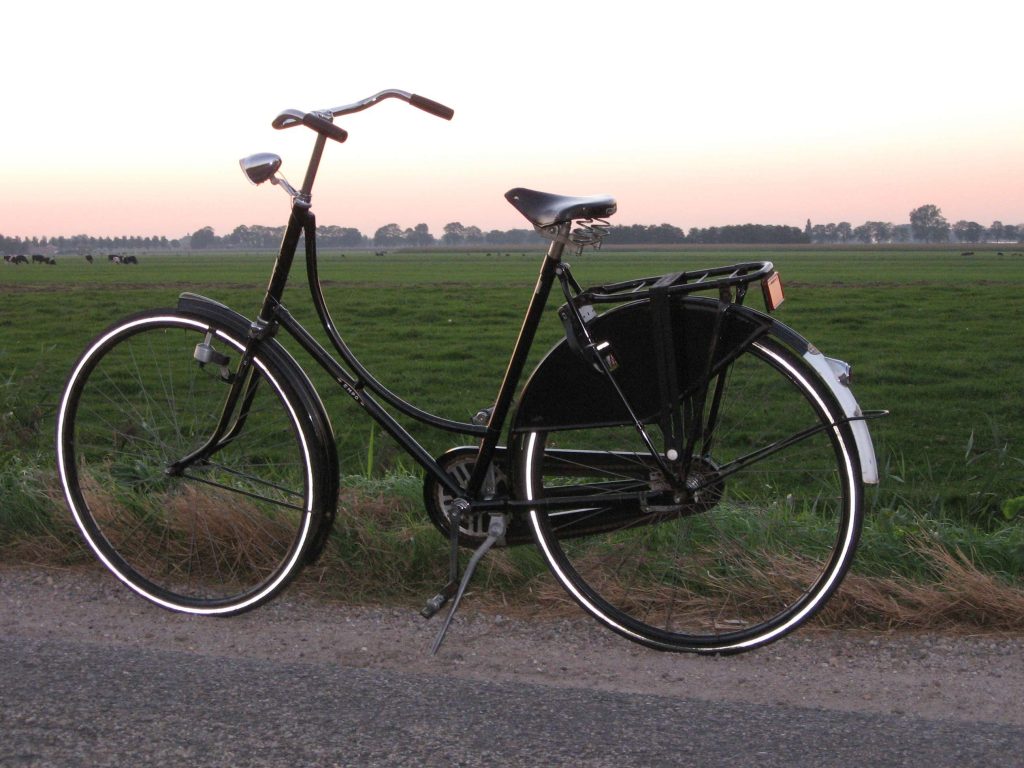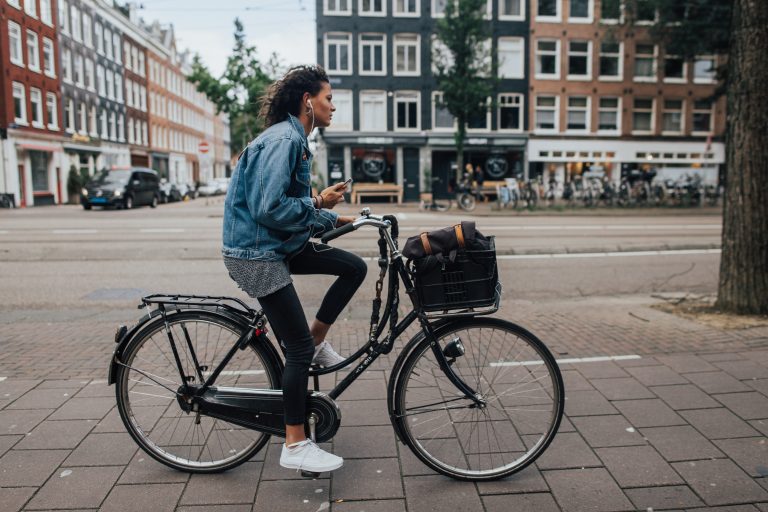Cycling is the most popular and convenient form of transportation in the Netherlands. If you’re living here you’ll need a bike. Amsterdam has more fietsen than people they say, so you’d think getting hold of a good bike for a decent price would be fairly easy. However there are a few potential pitfalls and things worth knowing before buying your first Dutch bike – all of which are covered in this guide.
Short on time?
Get Dutch-style omafiets or town bike from fietsen4all.nl – delivered straight to your door
Related: Bike frame sizes – how to know your size
Types of bike in the Netherlands
This guide is focused on popular Dutch-style bikes such as omafiets (granny bike) and and town bikes rather than racing bikes or e-bikes.
Omafiets

Omafietsen or “granny bikes” are what you will see most men and women riding in the Netherlands. They are favoured because of the low maintenance required due to sturdy steel frames, single gears and coaster brakes. All of which are less likely to break than more complicated bicycle set ups. Omafiets can be left out in the rain, bashed about in the bike parking, or fished out of a canal and will still get you from A to B without a hitch.
Coaster brakes are foot-pedal powered brakes. When coasting (without pedalling) you can apply pressure as if cycling backwards and it will activate the brake and slow you down to a halt. It takes some getting used to but becomes second nature fairly quickly. It can even be safer as it frees hands and fingers for signaling and focusing on controlling your bike rather than braking.
Omafiets are steel framed bikes. As such they are very heavy. Combine this with only having a single gear makes them far from ideal for cycling up hills or going on a long-distance cycle tour.
Herenfiets and damesfiets

There is no strict distinction between these bikes and omafiets. In general it seems herenfiets and damesfiets is used to refer to town bikes that have a few more features such as handlebar brakes, gears and some higher spec features that the simplified omafiets lacks. They can also be more lightweight and better suited for hills and/or longer distance cycling.
What about racing bikes, fixies, hybrids and e-bikes?
If you’re coming from a city like London where lycra-clad racing cyclists and fixed gear hipsters rule the cycle paths then you’ll be surprised how little of this there is in The Netherlands. Racing bikes are not really practical for day-to-day use here. People use them for sport rather than commuting. While many omafiets are single speed, you’ll rarely see a fixie, probably because of all the stopping and starting when cycling in Dutch cities. E-bikes are fairly popular but they’re expensive and more for use if you cycle long distances every day.
How much do bikes cost in the Netherlands?
A second hand bike can cost between €50 and €250 depending on the condition and quality of the bike. New bikes start around €250 for a simple omafiets and can go up to €800 for a really nice town bike from a good brand.
In a bike shop, second hand bikes are usually slightly more expensive at €200 or more. You can get them for less but be wary of buying the cheapest stock as it is often in poor condition and you’ll soon have to buy a new tyre, chain and brakes, or whatever else is wrong with it. The pros of buying at a good bike shop are that you can try out a few different bikes, haggle on price, and they should be in better condition due to being fixed up by the shop (not always the case).
Facebook is where you can find much cheaper bikes from €50. However some of these can be in terrible condition and may also be stolen. The bike may not be the same as in the picture so be prepared to walk away if it looks like a complete banger.
A better option than Facebook for finding a cheap used bike is Marktplaats, but again you should test the bike first and take a good look at it before handing over your cash.
Recommendations: Where to buy bikes
Bike shops and markets
De Pijp
Albert Cuypstraat in De Pijp also has bikes but they’re not as cheap and basic as Waterloo Plein. The bike shop at the end of the market (near Van Woustraat) is a good repair and bike tools shop and you can probably get a bike in good condition there if you want something more reliable. Another good place in De Pijp is De Stadfiets. However, shops in general are more expensive.
Central
Waterloo Plein market often has a large selection of cheap fairly basic oma bikes under €100. Look for issues with the bike and haggle the price down if possible.
Facebook groups
Facebook groups can be a good place to find a bike and cheaper than a shop. However, buying on Facebook can also have some pitfalls such as buying stolen bikes from pushy sellers (see below).
Some example Facebook groups for buying (and selling) bikes that are currently active:
Bike – Second Hand Bikes, Used Bicycles – Amsterdam
Amsterdam Expats online market
Online shops and bike leasing
There are also some cheap online-only options for getting a used bike:
As mentioned above, fietsen4all.nl is an online shop that delivers bikes across the Netherlands for less than €200.
Cheapassbikes.nl offer an used bikes starting at €85 which they promise are refurbished and fixed up. They also deliver the bike to your house (even if you are not going to be in they will lock it and post the key).
Bike leasing
Swapfiets is a hugely popular startup offering monthly bike leases. The pricing is reasonable at €16.50 per month and you get a good quality grandma bike. However, in the long run you’ll lost money – for example if you have a Swapfiets for 12 months it will cost you €198 which could buy you a decent bike with a good lock, lights and pay for upkeep for the same price which you can then sell if needed and get most of the money back. However, Swapfiets is very convenient because they’ll swap your bike if there’s a problem like a flat tyre and the bikes are good quality and if they get stolen you only have to pay €40. It is also a good short-term option and the contract is a rolling monthly contract.
Used bike buying checklist and haggling tips
Things to check on the bike whether from a Facebook seller or in a bike shop:
- Brakes – How good are they? If they’re pedal brakes, how worn out are they (i.e. how hard is it to stop the bike)
- Tyres – are the tyres cracked and worn out on the edges or do they look new. Is the tread worn out?
- Chain – is it rusty, loose, clicky when you cycle. The pedals may also feel like they rumble or are not smooth which is probably a worn out bottom bracket
- Bell – is there a bell and does it work (you’ll need a bell)
- Lock – is there a back wheel lock attached and does it work properly
- Seat – how worn out is it?
- Nuts and bolts – Are they rusted or have they been rounded off over time so you won’t be able to adjust the seat yourself
- Lights – does it have lights / reflectors and do they work
If any of the above seems dodgy then mention it and ask for a discount. Even if the bike is cheap to begin with it is worth haggling. Haggling is not unusual in the Netherlands with used goods so this will be a good opportunity to test your nerve against some Dutch directness. If you fail to get a discount then you lost to a seasoned professional so that’s fine too just don’t take it too seriously.
Stolen bikes on Facebook: Facebook sellers may be profiting from selling stolen bikes that aren’t theirs. If seller is pushy, has a sob story or the bike seems fishy (e.g. a broken wheel lock) just walk away and say you don’t like the bike.
Types of Dutch bikes
- Omafiets or grandma bikes are the most popular and cheapest options. They usually have an upright sitting position, rounded handlebars and a single gear with pedal brakes rather than hand brakes.
- City bikes are the next level up and can have gears and hand brakes. Popular brands for these bikes are Gazelle and Batavus.
- Bakfiets or bucket bikes are the bikes with big boxes at the front for carrying kids, dogs, whatever else you can fit in them. Not recommended for new arrivals to the Netherlands
- Trendy bikes. VanMoof bikes are fashionable designer bikes that aren’t cheap. You can lease them too.
- E-bikes. These are popular in the Netherlands. If you’re cycling long distances regularly they can be useful but they’re very expensive. There are also rental options but they can be around €100 per month.
Best type of bike for Amsterdam

The grandma bike is ubiquitous for a reason. These are solid sturdy bikes that need very little upkeep and can be left outside in the elements. They are not particularly fast or agile and can take some getting used to but are well suited for day-to-day use and commuting.
Tips for avoiding theft of your new bike
Bikes get stolen in Amsterdam and big cities in the Netherlands all the time. On moving to Amsterdam I bought a bike and it was stolen within a week because I used a cheap lock and left it in an isolated spot. Stealing and reselling bikes is an easy way for some people to make money.
Additionally if you leave your bike in the wrong place the municipality can take it away within hours and you may not be able to get it back from them if they can’t find it in the depot.
- Get a good quality heavy chain lock or d-lock. Some cheap chain locks look heavy duty but you can break the lock mechanism by bashing it hard enough making the chain redundant.
- Leave your bike in a designated bike parking area that is well lit and ideally within view of people. Some bike parking is not safe because it is in isolated spot (for example avoid the top floor of the multistory bike parking by Amsterdam Centraal)
- Lock your bike to something where possible
- If you are leaving your bike for a few days then always lock it to something
- Look for signs that say “geen fietsen plaatsen” or “verboden fietsen te plaatsen”. Leave your bike here and the municipality can take it away – sometimes within an hour
- Keep your purchase receipt and frame number should your bike be taken by the municipality this will help them find it in order to get it back
- Lock the wheels to the frame and the frame to a fixed bike parking frame or fence so that your wheels can’t be stolen

Great tips! In addition to these, I also tried out shared e-bikes in the Hague with a company called Bondi. It was super convenient plus really cheap to use e-bikes to get around town (only 0.24 euros per minute) with their app. And the bikes were always standing closeby so I didn’t have to look around for one, I could just check the app so that was really convenient